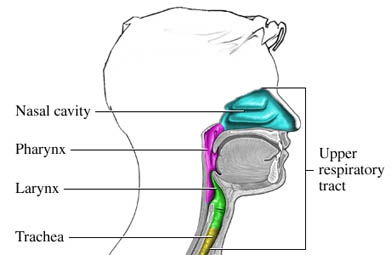Even though they are one of the most common ailments around, Upper Respiratory Tract Infections, or URIs, are one of the least understood. Even though almost anybody will get one sooner or later, few of us understand these infections or what causes them.
We need to be aware of respiratory tract infections because they are extremely common. Available statistics indicate that the average child will get five such infections a year and the average adult will suffer from two to three URIs each year.
What Is an Upper Respiratory Infection?
A URI occurs when a virus or a bacteria infects all or part of the upper respiratory tract, which consists of the nose, sinuses, pharynx, trachea, and bronchi. These are the areas through which air enters the body and travels to the lungs. These infections can be very serious because they sometimes spread to the lungs.
Most URIs are caused by viruses, which means that they cannot be treated with antibiotics. There are around 200 URI-causing viruses, most of which spread through the air. The two most common URI viruses are the common cold (rhinovirus) and influenza (the flu). The typical symptoms of a URI are usually caused by an allergic reaction to the infection itself.
Influenza is the most dangerous URI. Health authorities estimate that it causes 40,000 to 60,000 deaths a year in the United States. Other serious URIs include pneumonia and bacterial infections such as streptococcus (strep throat). Even though some URIs can lead to serious medical problems, most are minor ailments that clear up quickly with bed rest and other minor treatments.
What Are the Symptoms and Complications of Upper Respiratory Infections?
Symptoms of Upper Respiratory Infections
Sore throat
Runny nose
Coughing
Sneezing
Aches and pains
Painful swallowing
Fever
Headache
Fatigue
Insomnia
Malaise
Post nasal drip
Swelling of the throat
Soreness in other parts of the body
You need to pay attention to URIs because even mild cases can lead to serious complications that can lead to serious health problems. These health problems can lead to death or permanent disability if left untreated.
Potentially Dangerous Complications from Upper Respiratory Infections
Tonsillitis – swelling and abscesses on the tonsils
Pneumonia – infection of the lungs
Ear infections
Breathing problems
Worsening of asthma and other lung problems
Spread of infection to other parts of the body
Meningitis infection of the brain and nervous system
Rib fractures from coughing
When to See a Doctor
Each year many people become seriously ill and sometimes die because they mistake a serious URI for a minor ailment such as the common cold. These people could avoid dangerous complications by simply seeing a doctor.
Seek medical treatments immediately if one of the following circumstance take place:
When a patient has difficulty in breathing
When a person is unable to swallow food or drink
The symptoms last for more than a week
The symptoms get worse and not better, for that most people with URI will recover within two weeks
When a patient is in severe pain
If a person cannot stop coughing or sneezing
What Are the Risk Factors for an Upper Respiratory Infection?
The Main Risk Factors for URIs Include:
Breathing or lung problems, including asthma and allergies
Exposure to pollutants such as dust, smoke, and smog
Smoking
Exposure to cigarette smoke
Close contact with somebody that has a URI
Close contact with children, especially in a setting like a school
Not washing your hands
Spending time at any healthcare facility, including hospitals and clinics
A weakened or damaged immune system
Spending time in a closed space with a lot of people, such as airline travel
Injuries, particularly to the upper respiratory tract
Other health problems related to the upper respiratory tract, such as nasal polyps
Lack of rest, including fatigue and exhaustion
Poor physical shape resulting from lousy diet or lack of exercise
Serious health conditions, such as cancer or diabetes
Old age
Poor health from any cause
People that fit into any of these categories are more likely to catch a URI and more likely to suffer serious complications from one. Fortunately, some of these risk factors can be mitigated or eliminated with a healthy lifestyle in good habits. Simply stopping smoking and washing your hands a few times a day can greatly reduce your chances of getting a URI.
What Are the Treatments for an Upper Respiratory Tract Infection?
The good news is that most upper respiratory tract infections clear up after a few days. A healthy person’s immune system should be able to fight off a URI fairly quickly.
Fortunately, there are some things you can do to strengthen the body’s defenses and speed up the recovery process. There are even some effective home remedies for URIs:
Get plenty of rest by staying home from work or school, limiting physical activities, and getting eight to nine hours of sleep every night.
Drink plenty of liquids, including water, juice, milk, and tea, which can replace fluid losses and reduce post nasal drip.
Cough medicines can sometimes reduce coughing or at least limit its severity.
If home remedies fail or the upper respiratory tract infection gets worse, you should seek medical help as soon as possible. Serious URIs can sometimes quickly develop into life-threatening ailments.
- 1.
- 2.
- 3.


View All Comments /Add Comment